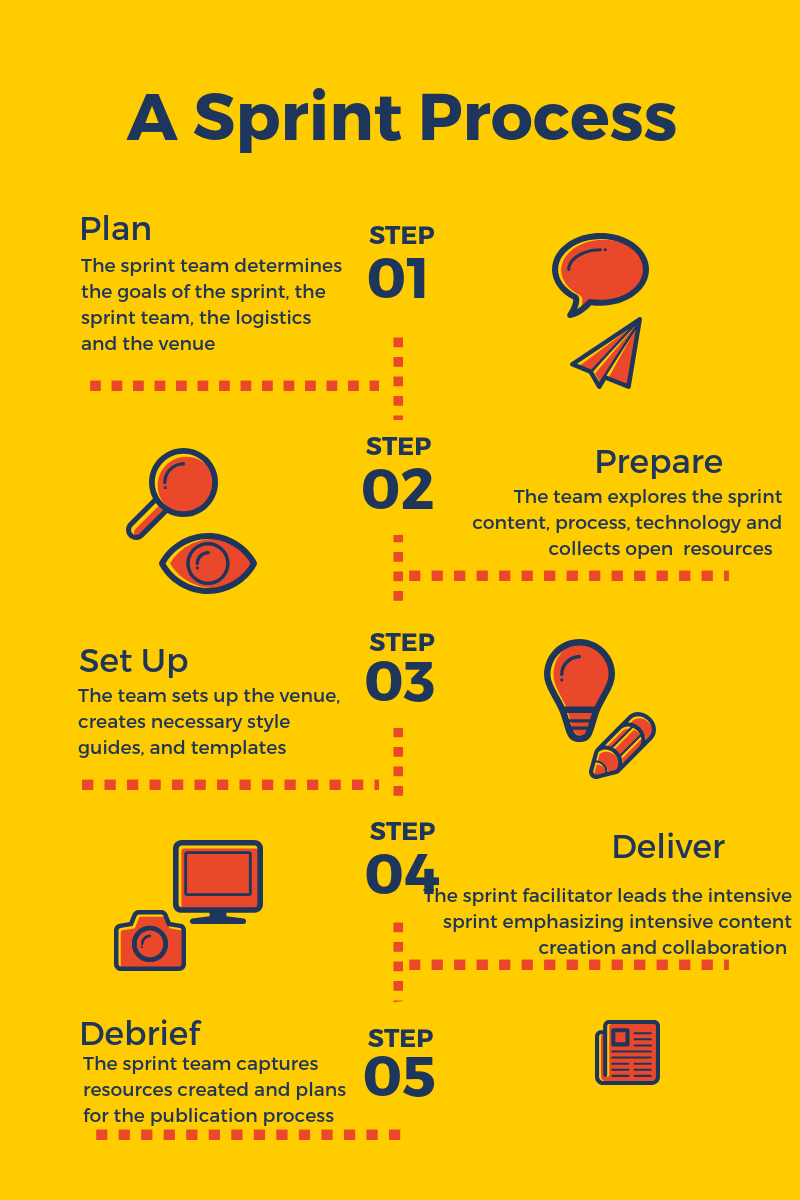Appendix 1: A Sprint Toolkit
What is a sprint?

Sprints are probably most associated with software design and are becoming increasingly used as a strategy or approach for developing open education resources (OER). The sprint approach can be used in a variety of contexts where a group of people (often cross-disciplinary) comes together to focus on a specific project. In post-secondary education, sprints are emerging as a way to accomplish a shared goal while working across disciplines and on a short timeline. Hackathons can follow a similar process but often have a competitive element.
The sprint methodology involves the following features:
- Short timelines and achievable goals
- Time-boxed working sessions (usually two to three days, but can vary according to context and needs)
- A defined outcome (i.e., textbook, resource)
- A planning process to develop the sprint process
- Multiple perspectives and skill sets
- Identified/agreed roles for participants
- Collaborative rather than competitive development processes
Principles
The principles at the heart of an effective sprint process have been well defined in the literature on agile project management—specifically the values of a scrum—which is a term used to describe a framework within which people can address complex problems. These include five values or principles which we think work well as a guide in planning your sprint:
- Focus. Stay focused on the goals of the sprint.
- Commitment. Commit to the sprint process, timeline, and goals.
- Openness. Highlight where help is needed and identify blocks to progress during the sprint work.
- Respect. All contributors have a purpose and all contributions are valued.
- Courage. Have the courage to change direction if called for and the courage to open up to new ways of thinking surfaced by the group.[1]
Book sprints
A book sprint brings together a group of experts to produce a finished book in three to five days. No advance preparation by participants is required—the group is guided by a skilled facilitator, from zero to published book. (This includes written content, illustration, and design.) The content of the finished book is high quality and is often made available immediately at the end of the sprint in all major digital formats and print-on-demand.
Example: British Columbia in a Global Context textbook sprint
Resource sprints
The basic motivation for an OER sprint is to bring people together to produce a resource that would otherwise not be created. It’s a great way to bring together the skills, energy, and enthusiasm of people to collaborate to achieve something they could not achieve on their own.
OER sprints create and remix open educational resources for adoption and adaption in education.
Examples: Open Case Studies Sprint, Open Science Course Sprint, and How to Conduct Paper Sprints [PDF]
Image descriptions
Figure 4 image description: A Sprint Process. The steps are as follows:
- Plan. The sprint team determines the goals of the sprint, the sprint team, the logistics, and the venue.
- Prepare. The team explores the sprint content, process, technology, and collections open resources.
- Set up. The team sets up the venue and creates necessary style guides and templates.
- Deliver. The sprint facilitator leads the intensive sprint, emphasizing intensive content creation and collaboration.
- Debrief. The sprint team captures resources created and plans for the publication process.
Media Attributions
- A Sprint Process © Lucas Wright is licensed under a CC BY (Attribution) license
- Dave West, "Updates to the Scrum Guide: The 5 Scrum values take center stage," Scrum.org, https://www.scrum.org/resources/blog/5-scrum-values-take-center-stage (accessed February 14, 2019). ↵

